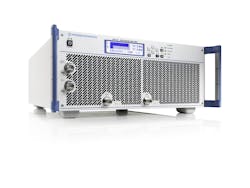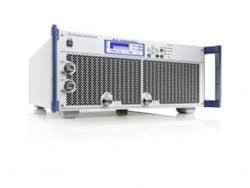Rohde & Schwarz broadband amplifiers offer tunable transmission characteristics
Munich, Germany. Rohde & Schwarz describes its R&S BBA130 broadband amplifiers as the first in the 80-MHz to 6-GHz range that allow users to optimize the transmission characteristics to the requirements of a specific application. The operating class for the transistors can be adjusted between Class A and Class AB during operation. The tolerance against mismatch at the output can also be changed to provide more power. Just one amplifier covers a variety of test scenarios during design and product validation.
The company said new technologies and innovations such as eMobility, Internet of Things, 5G, and satellite communications are driving markets, bringing about many new developments in the field of wireless communications—in particular RF components, subsystems, and systems. The R&S BBA130 broadband amplifier family addresses a range of tests during design and product validation. The R&S BBA130 broadband amplifiers were designed for use in development, production, and quality assurance and offer output powers from 22 W to 4,200 W in the 80-MHz to 6-GHz frequency range. Thanks to their compact, modular design, the amplifiers can be optimally scaled and configured. This modular design also provide a secure investment with the option to add future power and frequency range upgrades.
Varying the bias point for the transistors changes the output signal characteristics. A bias point in Class A yields good linearity and good harmonic performance and is suitable for generating spectrally clean CW signals. A bias point in Class AB provides faithful reproduction of pulsed signals and improves the efficiency of the amplifier.
The modular design of the R&S BBA130 family enables flexible dual-band configurations with two different frequency ranges in one housing. Twin-band configurations with two identical amplifiers in one housing are also possible. With its compact dimensions, the R&S BBA130 family is optimized for maximum flexibility in a small footprint. An RF output power of up to 750 W below 1 GHz and up to 300 W above 1 GHz in just four height units demonstrates the amplifier family’s power density. The amplifiers can be combined into highly integrated systems with flexible frequency and power configurations.
With R&S BBA130 amplifiers, users can adjust the operating class, select between high output power and high mismatch tolerance, extend the frequency range. and scale the output power. They are now available from Rohde & Schwarz in the frequency ranges from 80 MHz to 1.0 GHz, 0.69 GHz to 3.2 GHz, and 2.5 GHz to 6.0 GHz with output power levels of 22 W to 4,200 W.
About the Author

Rick Nelson
Contributing Editor
Rick is currently Contributing Technical Editor. He was Executive Editor for EE in 2011-2018. Previously he served on several publications, including EDN and Vision Systems Design, and has received awards for signed editorials from the American Society of Business Publication Editors. He began as a design engineer at General Electric and Litton Industries and earned a BSEE degree from Penn State.

